Tokusetsu-Yusokan
IJN T.101 Class Landing Ship Tank
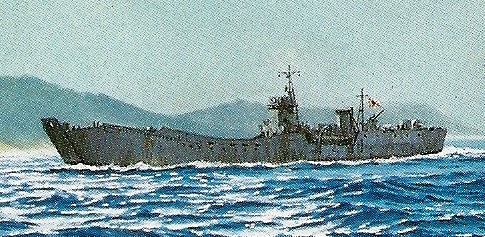 (T.101 Class Landing Ship Tank by T. Yuki)
(T.101 Class Landing Ship Tank by T. Yuki)
IJN LST T.149:
Tabular Record of Movement
© 2014 Bob Hackett
Rev 1
1 November 1943:
Mukojima. Laid down at Hitachi K. K. as Hull No. 1549, a 950-ton T. 101-class landing ship tank.
25 December 1943:
Launched.
5 February 1944:
Numbered T.149
20 February 1944:
Completed. Lt Maekawa Shinichi is the Commanding Officer. Attached to the Kure Guard Force.[1]
21 February 1944:
Departs for Onomichi harbor, but returns as a result of compressor troubles. Arrives at Onomichi later that evening.
22 February 1944:
Departs Onomichi for Kure.
25 February 1944:
Departs Kure for sea tests. Later, arrives at Osako, Kurahashi Island.
26 February 1944:
At 1000, conducts seashore docking experiment.
27 February 1944:
Off Osako. After 0900, conducts embarking and disembarking tests with Type 3 "Ka-Chi" amphibious and Type 95 "Ha-Go" light tanks.
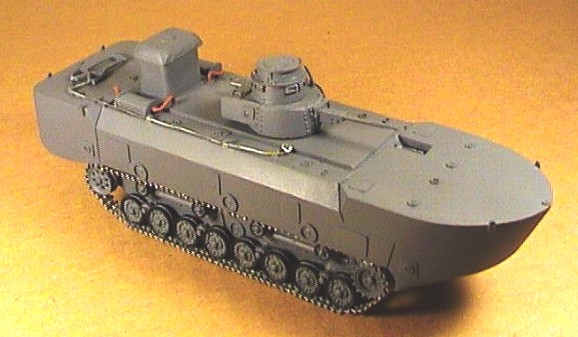
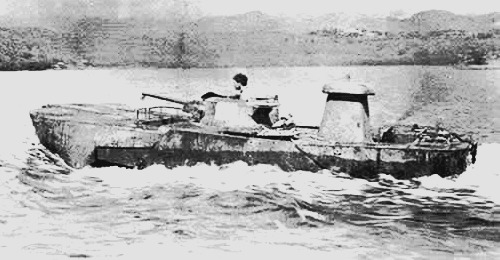
(IJN Type 3 "Ka-Chi" Special Naval Landing Force Amphibious Medium Tank showing its 47mm Type 1 main gun)
28 February 1944:
Continues tank embarking and disembarking tests. Departs Osako and arrives at Kure.
2 March 1944:
At Kure. Conducts truck embarking and disembarking tests. Later that day departs Kure for Osako, arriving that same evening.
3 March 1944:
Off Osako-Nasake Jima. Conducts tank launching and retreival tests.
4 March 1944:
Osako. T-149 conducts tank launching and retreival tests.
5 March 1944:
Departs Osako and arrives at Kure.
7 March 1944:
At 0933, transferred to berth pontoon C.
15 March 1944:
At 1220, loads fresh provisions. Departs Kure and arrives at Osako.
16 March 1944:
At 0756, T.149 docks at Osako. Loads ten Type 2 "Ka-Mi" amphibious tanks and 87 tank crewmen;
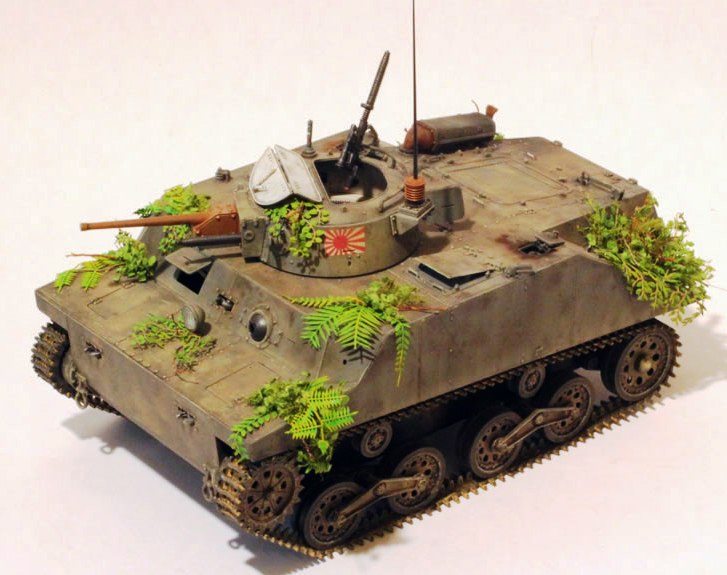 (IJN Type 2 "Ka-Mi" Special Naval Landing Force Amphibious Tank showing its
(IJN Type 2 "Ka-Mi" Special Naval Landing Force Amphibious Tank showing its
37 mm Type 1 main gun and 7.7mm Type 99 machine gun - Dragon 1/35 scale
model)
18 March 1944:
Departs Osako for Shido Bay, conducting navigational exercises en route. Arrives that evening.
19 March 1944:
Departs Shido Bay for Yuasa Bay.
20 March 1944:
Departs Yuasa Bay for Yokosuka. At 1400, conducts anti-aircraft gun practice.
20 March 1944:
At 1400, conducts anti-aircraft machine gun practice.
21 March 1944:
Arrives at Yokosuka.
23 March 1944:
At 1130, loads raw food products, fresh water and fuel oil. Departs Yokosuka.
24 March 1944:
Arrives at Tateyama.
25 March 1944:
At, 2025, a Tateyama Naval Flying Corps reconnaissance seaplane crashes into into T.149's starboard boat deck and destroys her nine-meter cutter.
27 March 1944:
Departs Tateyama for Futami Bay.
31 March 1944:
Arrives at Futami Bay.
1 April 1944:
At 1100, 26-ship convoy Higashi-Matsu No. 4 departs Tokyo. The ships and their destinations are:
Saipan: T.149 and AKIKAWA, KAKOGAWA, KOKO, MAKASSAR, SHIRAMINE, SHOUN, TAIKAI, TAKASAN and TOKO MARUs
Guam: AZUCHISAN, MIMASAKA, NISSHU and TOAN MARUs and UNYO MARU No. 8
Truk: Fleet supply ship KINESAKI and HAVRE, SHIMA, SHINYO, SHOZUI and TATBEI MARUs.
Palau: Fleet supply ship MAMIYA, TENRYUGAWA, TAIAN and TOSEI MARUs and SHINSEI MARU No. 5
Yap: SHINSEI MARU.
The convoy commander is Rear Admiral Kiyota Takahiko (42)(former CO of NACHI) in destroyer SAMIDARE. The other escorts include destroyer ASANAGI, torpedo-boat HIYODORI, kaibokan AMAKUSA, FUKUE, MIKURA, OKI, CD-2, CD-3 and subchaser CH-50.
3 April 1944:
5 miles S of Tori-Shima. At about 1457, LtCdr (later Rear Admiral-Ret) Bafford E. Lewellen's (USNA ’31) USS POLLACK torpedoes and sinks TOSEI MARU at 30-14N, 139-45E. Only one passenger is KIA. The escorts counterattack POLLACK and drop 55 depth charges unsuccessfully.
5 April 1944:
T.149 joins the convoy at 1346.
8 April 1944:
N of Saipan. At 0228 (JST), LtCdr (later Vice Admiral) Frederick J. Harlfinger's (USNA ’37) USS TRIGGER (SS-237) fires four torpedoes at the convoy, but fails to get any hits. OKI and SAMIDARE counter-attack with depth-charges and damage TRIGGER.
9 April 1944:
62 miles WNW of Saipan. At 1634, LtCdr (later Captain) Slade D. Cutter's (USNA ’35) USS SEAHORSE (SS-304) torpedoes and hits MIMASAKA MARU at 15-30N, 145-00E. MIMASAKA MARU is taken in tow by TOAN MARU. The escorts counter-attack SEAHORSE unsuccessfully.
10 April 1944:
At about 0100 (JST), MIMASAKA MARU founders. She is carrying over 1,000 Naval personnel, most of whom are rescued, but seven troops and 11 crewmen are KIA. The convoy arrives at Saipan, then is split into separate groups that continue on to their respective destinations.
Saipan. At 1340, T.149 lands nine IJN Type 2 amphibious tanks of the 55th Guard Force/No. 1 Yokosuka Special Naval Landing Force. At 1440, T.149 transfers 102 men to TOAN MARU for movement to Guam..
11 April 1944:
Saipan. 0900, loads fresh water. At 1325, lands the remaining amphibious tank.
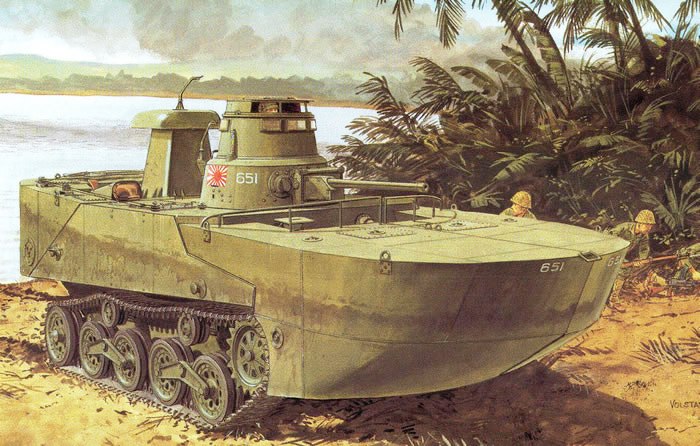 (IJN Type 2 "Ka-Mi" Amphibious Tank showing its
(IJN Type 2 "Ka-Mi" Amphibious Tank showing its
detachable bow and stern pontoons)
12 April 1944:
Departs Saipan and arrives at Guam.
13 April 1944:
Starting at 1520, loads two trucks; one large passengers car; one fuel truck; one water sprinkler truck to dampen dust on airfields; one three-wheeled fire truck; one oxygen generating truck; one lathe machine tool, one generator, one radar detector and
a naval officer, seven naval non-commissioned officers and sailors, two army soldiers and two workers.
14 April 1944:
Departs Guam for Rota, arriving that morning. After 1125 , unloads her cargo of trucks.
Departs Rota for Saipan that evening.
15 April 1944:
Arrives at Saipan.
20 April 1944:
At 1530, completes transport of 170 tons of equipment and departs Saipan.
22 April 1944:
Arrives at Guam.
24 April 1944:
Departs Guam.
26 April 1944:
Arrives at Palau. Later that day, T. 149 departs Palau with escorted by light cruiser YUBARI and destroyers SAMIDARE and YUZUKI.
27 April 1944:
On her first war patrol, LtCdr (later Captain) Eric L. Barr's (USNA ‘34) USS BLUEGILL (SS-242) is reconnoitering the Sonsorol (now Dongosaro) Islands, SW of Palau when YUBARI arrives. BLUEGILL sights her and a destroyer, but YUBARI disappears behind the island. She proceeds to disembark her troops and departs at 0942.
YUBARI suddenly reappears from behind the island at top speed. Barr quickly changes his set-up, swings BLUEGILL to the new firing course and fires six torpedoes. YUBARI evades four torpedoes of the first spread, but at 1004, she is hit starboard side in her No. 1 boiler room. One officer and 16 sailors are KIA in No. 1 boiler room. All engines stop and the cruiser goes dead in the water. By 1030, boiler rooms Nos. 1 and 2 are flooded. After 1400, an attempt to get underway on her middle shaft fails.
At 1650, SAMIDARE attempts unsuccessfully to tow YUBARI.
28 April 1944:
At 0541, DesRon 3's flag is transferred to YUZUKI. At 0544, YUZUKI rescues survivors. At 1015, almost 24-hours after she was torpedoed, YUBARI sinks by the bow at 05-38N, 131-45E. Nineteen crewmen are KIA.
8 May 1944:
At 0725, T.149 comes alongside Palau’s south pier. From 0900 ~ 1145 she loads cargo and from 1149 ~ 1555, loads fresh water and fuel.
9 May 1944:
At 1615, T.149 loads six anti-aircraft guns, 11 vehicles, food and 180 tons of cargo.
10 May 1944:
T.149 departs Palau for Halmahera carrying the 87th Navy Air Defense Unit, 211 men and six anti-aircraft guns, 22 workers of the No.102 Naval Repair Facility and 11 vehicles and 180 tons of other supplies.
12 May 1944:
Arrives at Morotai Island, N of Halmahera.
13 May 1944:
Departs Morotai Island for Kau, Halmahera.
15 May 1944:
Lands the 87th Navy Air Defense Unit.
16 May 1944:
Completes unloading materials and departs Kau.
20 May 1944:
Anchors at Morotai Island.
23 May 1944:
Arrives at Palau.
24 May 1944:
At 1258, T.149 comes alongside Palau’s south pier.
25 May 1944:
At 1403, starts loading fresh water and fuel.
26 May 1944:
From 0830 ~ 1105, T.149 loads Army equipment.
29 May 1944:
From 0945 ~ 1130, loads Navy equipment.
30 May 1944:
From 1000 ~ 1130, T.149 loads Navy equipment. At 1615, embarks 168 IJA troops and 120 men of the 85th Naval Guard.
31 May 1944: Operation “KON” - The Reinforcement of Biak:
At 0913, destroyer URANAMI anchors near T.149 and material transfer starts until completed at 1108.
1 June 1944:
Departs Palau.
4 June 1944:
Arrives at Sorong, New Guinea. At 1920, T.149 begins unloading 12 army trucks, one passenger car, about 100 tons of ammunition and two navy trucks, 13-mm AA machine gun mounts and about 70 tons of ammunition, rations and medical supplies
5 June 1944:
At 0045, loads 168 army troops and 170 Navy personnel and departs Sorong island.
9 June 1944:
Departs Sorong for Ambon.
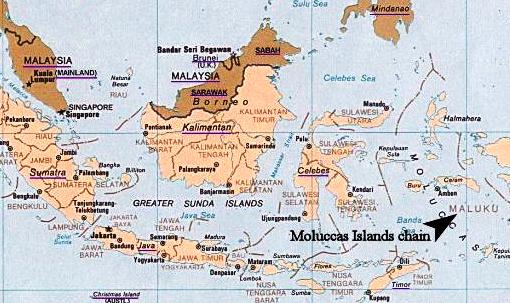 (Modern Map of Indonesia)
(Modern Map of Indonesia)
10 June 1944:
Arrives at Ambon, Moluccas.
13 June 1944:
At 1400, starts loading cargo.
14 June 1944:
At 0905, T. 149 comes alongside Ambon’s pier. From 1000 ~ 1150, loads heavy oil and fresh water.
15 June 1944: American Operation "Forager" - The Invasions of Saipan, Tinian and Guam, Marianas:
Vice Admiral (later Admiral) Richmond K. Turner's (USNA '08) Task Force 52 lands Marines on Saipan under cover of intensive naval gunfire and carrier-based aircraft.
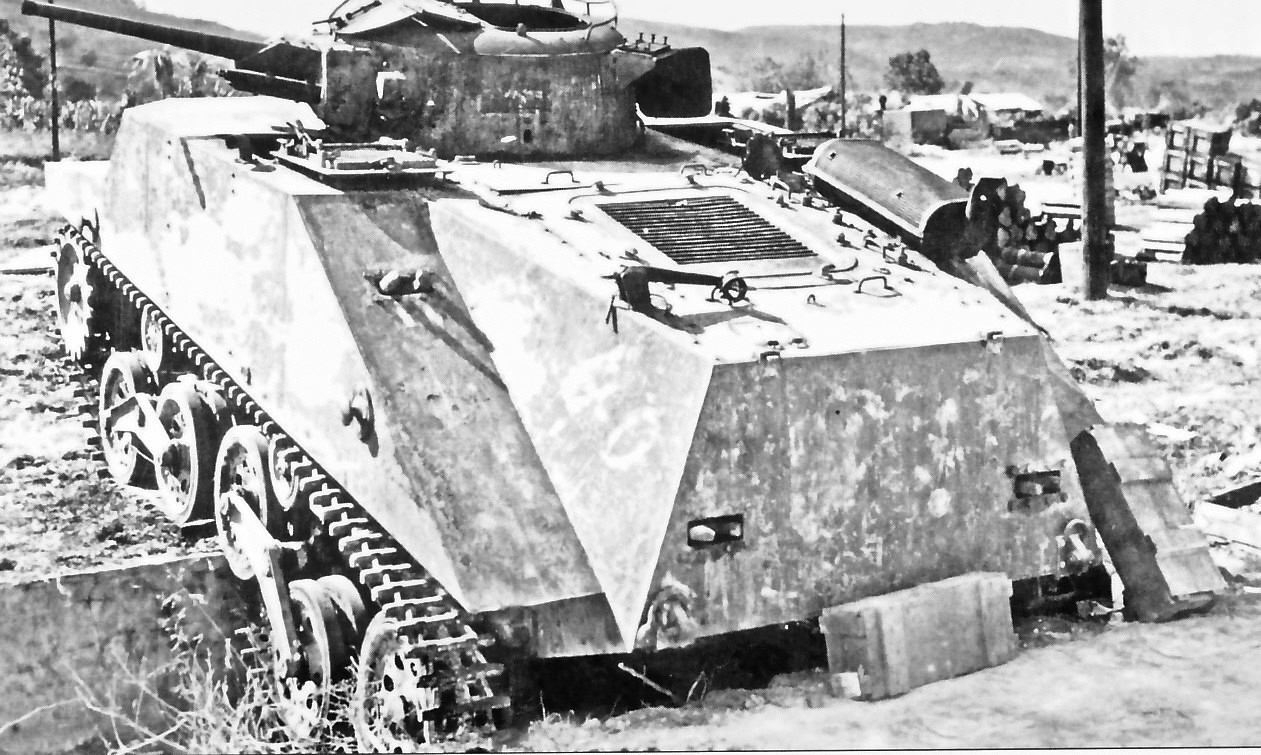 (IJN Type 2 "Ka-Mi" Amphibious Tank knocked out on Saipan)
(IJN Type 2 "Ka-Mi" Amphibious Tank knocked out on Saipan)
That same day, at 0844, T.149 docks near Ambon’s third pier and at 0900 starts loading cargo.
16 June 1944:
At 1840, completes loading cargo.
17 June 1944:
Departs Ambon.
20 June 1944:
T.149 suffers an air compressor pump failure. Arrives at Kofiau Island in West Papua's Raja Amphat Island group. At 2031, destroyer HOKAZE arrives to assist.
21 June 1944:
Minesweeper W-22 also arrives to assist.
That same day, off Sanana, Soela islands between Sorong and Kau Roads, Moluccas, minelayer TSUGARU is torpedoed by Dutch Ltz. I Jacob F. Drijfhout van Hooff's submarine HNMS K-XIV at 01-10S, 130-30E (extent of damage unknown). At 1140, HOKAZE is dispatched to assist TSUGARU. W-22 remains with T.149.
Later that day, T.149 departs Kofiau Island and arrives at Gebe Island at easternmost end of North Maluku. At 1745, W-22 also arrives at Gebe Island.
22 June 1944:
T.149 departs Gebe and arrives at Buri Bay, Ingerangu Island's west anchorage.
23 June 1944:
At 1616, meets auxiliary minesweeper Wa-3.
24 June 1944:
Arrives at Tobero and departs, then arrives at Michi. At 1405, experiences docking failure and cargo handling difficulties because of machinery breakdown. At 1501, docks and starts landing cargo until 2029. Anchors offshore at 00-34N-128-03E.
25 June 1944:
At 0635, docks and starts landing cargo. At 1115, completes loading two 120mm guns, one search light and other things. Departs Michi and arrives at Galera Pier. At 1645, berthis and starts landing cargo until 1849 then anchors.
26 June 1944:
At 0658, docks and starts landing cargo. At 1522, completes landing two 120mm guns, one search light and other things. At 1838, anchors.
27 June 1944:
Arrives at Rimau. At 0800, berths and begins unloading which is completed at 1235. Departs that same day and arrives at Maluku, Seram Island, Moluccas.
2 July 1944:
Secures from an air raid alarm.
3 July 1944:
From 1005 ~ 1445, T.149 loads empty drums. That same day, departs Maluku and arrives at Kau, Halmahera.
11 July 1944:
Departs Kau and arrives at Maluku.
12 July 1944:
Receives a confidential message No. 122141 from the 26th Special Base Force to return to Kau.
13 July 1944:
Maluku. T.149 comes alongside an unidentified tanker and loads 9 tons of heavy oil.
15 July 1944:
Departs Maluku and arrives at Kau.
16 July 1944:
Arrives at Morotai. A Consolidated B-24 "Liberator" heavy bomber-reconnaisance aircraft overflies the anchorage. Surface-to-air combat ensues with unknown results.
18 July 1944:
Arrives at Palau.
20 July 1944:
Palau. By 1800, cargo handling ends.
21 July 1944:
At 0700, T-149 departs Palau for Kau escorted by subchasers CH-12 and CH-26.
23 July 1944:
At 1444, probably drops four depth charges.
24 July 1944:
At 1400, arrives at Kau.
26 July 1944:
Departs Kau.
27 July 1944:
At 1330, T.149 runs aground on Halmahera's W Coast at 01.26N, 128.29E. Later, she is refloated.
2 August 1944:
Arrives at Ambon.
4 August 1944:
At 0755, comes alongside Ambon’s pier. Loads heavy oil and fresh water.
7 August 1944:
At 0745, begins cargo handling. At 1114, engages in surface-to-air combat. At 1403, completes cargo handling. At 1615, anchors.
8 August 1944:
T.149 borrows a 25mm machine gun and fits it forward of the tank deck bridge. Departs Ambon and arrives at Kaira. At 1845, begins cargo handling.
9 August 1944:
At 0437, completes cargo handling. Departs Kaira and arrives at Ambon.
10 August 1944:
Departs Ambon and arrives at Kaira. At 2130, completes cargo handling.
11 August 1944:
Departs Kaira and arrives at Ambon.
18 August 1944:
At 1235, T-149 and T-151 depart Ambon escorted by subchaser CH-60.
19 August 1944:
At 2330, arrives at Toeal (Tual).
20 August 1944:
At 0015, departs Toeal.
21 August 1944:
At 0430, arrives at Ambon. At 1124, loads 650 personnel and 150 tons of material.
23 August 1944:
At 1300, T-149 and T-151 depart Ambon escorted by subchaser CH-60.
27 August 1944:
At 1425, arrives at Makassar.
30 August 1944:
By 1700, completes loading passenger cars, sprinkler, one tractor, one launch, 100 tons of materials and 400 employees.
31 August 1944:
From 1200 ~ 1600 loads fuel oil and fresh water. Embarks 250 coolie men.
1 September 1944:
At 0740, T-149 and T-151 depart Makassar escorted by subchaser CH-60.
2 September 1944:
Arrives at Besar Island.
3 September 1944:
Arrives at Korono Bay.
4 September 1944:
T-149 engages in surface-to-air combat. Her 25mm AA machine guns fire 45 rounds.
5 September 1944:
At 0635, the convoy arrives at Ambon. At 1630, disembarks 170 tons rations and 247 coolie men.
That same day, T.149 is re-classified as a 2nd class Yusokan attached to Kure Naval Station.
 (T.149 underway)
(T.149 underway)
6 September 1944:
Departs Ambon for Kendari, Celebes (Sulawasei).
8 September 1944:
Arrives at Kendari. Transfers passengers to SHOEI MARU.
10 September 1944:
At 1740 completes cargo handling. Departs Kendari.
12 September 1944:
Arrives at Ambon. Comes alongside Ambon’s No. 1 pier. By, 1320, completes handling of 16 tons of food.
13 September 1944:
At 1342, engages in surface-to-air combat with unknown results. Arrives at Korona Bay (04-15S, 122-46E.)
14 September 1944:
Arrives at Kendari.
15 September 1944:
From 0928 ~ 1245 unloads material.
17 September 1944:
T.149 receives Southwest Fleet order No. 618 that directs "After repairs [are] completed in Surabaya proceed to Balikpapan via Manila." [1]
19 September 1944:
From 0840 ~1715, loads cargo and embarks 300 passengers and 30 tons of material.
20 September 1944:
Departs Kendari.
23 September 1944:
Arrives at Makassar, Celebes.
24 September 1944:
At 0957, comes alongside Makassar’s south pier. At 1053, begins loading heavy oil and fresh water.
26 September 1944:
Departs Makassar.
29 September 1944:
Arrives at Surabaya, Java.
2 October 1944:
Enters dock.
7 October 1944:
Undocked. [1]
9 October 1944:
T.149 is taken under tow.
28 October 1944:
Re-enters dock.
30 October 1944:
Southwest Area Fleet issues emergency transportation order No. 490 that directs T.149 to proceed to Singapore via Manila. [1]
1 November 1944
At 0835, undocked.
2 November 1944
T.149 comes alongside the berthing pier. At 1259, loads machine tool, ammunition and rations.
4 November 1944
Arrives at Surabaya's Jiyabara bunker anchorage.
5 November 1944
Departs Surabaya.
6 November 1944
Arrives at Cheribon, Java and departs..
7 November 1944
Arrives at Muntok, Sumatra.
10 November 1944
At 0900, T.149 arrives at Singapore's Seletar naval port and comes alongside quay No. 9. At 1008, starts cargo handling that is completed by 1540.
11 November 1944
At 0035, a water barge comes alongside. Later, T.149 comes alongside quay No. 8.
15 November 1944
At 1630, departs Seletar.
18 November 1944
At 0645, T. 149 departs Singapore for Manila in convoy SHIMA-05 also consisting of MANILA, KENEI and TASMANIA MARUs, SHINSEI MARU No. 5 and tanker AYANAMI MARU escorted by kaibokan KURAHASHI, CD-31, CD-32, patrol boat PB-104 and subchaser CH-56.
24 November 1944
The convoy arrives at Miri, Borneo and departs at 1710. KENEI MARU remains behind.
25 November 1944
90 miles NW of Miri. At 0535, LtCdr John R. Madison's (USNA '37) USS MINGO (SS-261) torpedoes MANILA MARU and gets three hits. MANILA MARU explodes and sinks in four minutes at 05-42N, 113-15E. Captain Uike Matsuichi, 97 crew and 51 gunners are KIA.
29 November 1944
The remainder of convoy SHIMA-05 arrives at Manila. At 1943, T.149 comes alongside the east pier and cargo handling begins.
2 December 1944:
At 2000, T.149 arrives at Cavite Navy Base where a generator is repaired.
3 December 1944:
At 0700, T.149 arrives at Manila’s commercial harbor. Later that day, departs Manila.
4 December 1944:
NW of Palawan Island. About 1300, LtCdr (later Captain) George W. Grider’s USS FLASHER (SS-249) intercepts a convoy enroute from Manila to Singapore consisting of HAKKO MARU escorted by destroyer KISHINAMI, kaibokan CD-17 and minelayer YURIJIMA.
FLASHER torpedoes and sinks destroyer KISHINAMI at 12-54N, 116-27 E and damages HAKKO MARU that begins burning. T.149, which is nearby, arrives at the scene and assists in rescuing survivors.
At 1052, USN codebreakers intercept a message from YURIJIMA that says “Torpedo attack, damage incurred. Position 12-54 N, 116-27 E -- and HAKKO MARU ---.”
At 1800, rescue work is discontinued.
At about 1900, FLASHER returns and again torpedoes HAKKO MARU that sinks at 13-12N, 116-37E. YURIJIMA rescues 150 of KISHINAMI’s survivors. CD-17 also rescues survivors of the sinkings.
5 December 1944:
At 1020, USN codebreakers intercept another message from YURIJIMA that says “Have picked up following personnel: --- --- Division Commander and 128 men (6 seriously wounded), Master of HAKKO MARU and --- men. 22 Army and 263 Naval passengers (of whom 9 are seriously and 1 lightly wounded.) YURIJIMA will proceed as follows: ---.”
7 December 1944:
Arrives at St Jacques, then departs for Saigon.. At 2200, passengers are disembarked.
13 December 1944:
Departs St Jacques for Singapore.
19 December 1944:
Arrives at Seletar Naval Base.
22 December 1944:
At 1330, comes alongside a quay
29 December 1944:
Loads provisions.
31 December 1944:
Departs Singapore.
8 January 1945:
Arrives at Saigon.
11 January 1945:
At 1100, T. 149 departs Saint Jacques for Takao, Formosa in convoy SATA-05 also consisting of AYAYUKI, EIHO (ex-Dutch PENDOPO), KENSI and TOYU MARUs escorted by kaibokan CD-35 and CD-43, patrol boat PB-103, minesweeper W-101 and subchaser CH-31. In the evenning, T-149 finds the heavy seas too dangerous. She is detached from the convoy and returns to St. Jacques.
12 January 1945: Operation "Gratitude"- Task Force 38's Strikes on Indochina:
15 miles S of Cap Padaran, Indochina. Aircraft of Vice Admiral (Admiral posthumously) John S. McCain's (USNA ’06) Task Force 38 attack SATA-05 and severely damage T. 149 at 10-20N, 107.50E.
At about 0830, ten planes also bomb and strafe KOSHIN MARU. She suffers two direct hits and many near misses that hole and flood the ship. At 0925, KOSHIN MARU sinks at 11-08N, 108-49E. 44 crewmen are KIA.
CD-35 goes down at 11-10N, 108-55E after receiving three direct bomb hits with 69 hands. A few survivors reach the shore after a 4-hour swim and are later transferred to Saigon. CD-43 is strafed and receives several near misses. After her steering compartment is flooded, the escort is beached on an uninhabited island at 11-10N, 108-55E and later blown up by her crew. 29 sailors are KIA. The planes also damage KYOEI MARU No. 3 and LST T.137. TF-38’s planes eventually sink the entire convoy.
Saint Jacques. At 0957, TF-38’s aircraft strafe T.149. LtCdr Maekawa is KIA by machine-gun fire. He is promoted LtCdr posthumously.
1 February 1945.
Saigon, Indochina. T.149 undergoes emergency repairs and conversion to a communications ship.
10 February 1945.
Renamed KUROSHIO MARU No. 2. She is rearmed with one 76mm AA gun, six 25mm Type 96 AA machine cannons. and 12 DCs. Attached to the Sasebo Naval Trade & Logistics section
28 February 1945.
Repairs and conversion completed.
13 May 1945: Japanese Operation "Sho” – The Evacuation of the Andaman and Nicobar Islands, Indian Ocean:
The Nicobar evacuation group, comprised of auxiliary supply ship KUROSHIO MARU No. 2 (ex-landing ship T-149) and subchaser CH- 57, arrives at Nancowry Island, Nicobar Islands. Four hundred -fifty troops are embarked.
14 May 1945:
At 2000, the evacuation group departs Nancowry Island for Penang. Malaya Within hours of departure, KUROSHIO MARU No. 2 and CH- 57 are sighted by a patrolling RAF Consolidated B-24 "Liberator" bomber of No. 222 Group 4 based at Ceylon (Sri Lanka).
15 May 1945:
The evacuation group is attacked by two aircraft at 07-10N, 96-24E. CH-57 claims one as shot down.
16 May 1945:
USN Fleet Radio Unit, Melbourne, Australia (FRUMEL) codebreakers intercept and decrypt a message from CH-57 that reads: "Owing to fierce squall at 0320 south of Butang Is. I lost sight of No. 1 KUROSHIO. (FRUMEL misidentified the ship as KUROSHIO MARU No. 1). I searched but I could not find her. I arrived Penang at 1200."
12 June 1945: British Operation “IRREGULAR:
Off Rondo Island, 20 miles N of Sabang, Sumatra. Alerted by submarine HMS TRIDENT, the Royal Navy's Destroyer Flotilla 10’s HMS ESKIMO, NUBIAN, PALADIN, PENN and TARTAR intercept KUROSHIO MARU No. 2 and CH-57. KUROSHIO MARU No. 2 is hit by torpedoes from HMS ESKIMO and explodes. The destroyers also engage and sink CH-57 with gunfire at 06-20N, 94-45E. Some of the survivors refuse rescue. [2]
At 0932, USN codebreakers intercept and decrypt a message from the CO of the Sabang Base Force that reads: “KUROSHIO MARU No. 2 and CH-57 were shelled by 3 ---- ships and sank at (0915?) in position bearing ----- degrees (25?) kilometers from Sabang.”
13 June 1945:
At 1731, USN codebreakers intercept and decrypt a message that reads: “Action Summary: - CH-57 and KUROSHIO MARU No. 2 , while outward bound on 2nd phase Shoo operations (withdrawal of Army forces from Andaman Islands) screened by Army plane at 0820 approximately 20 miles N of Sabang encountered 3 enemy destroyers. They engaged the enemy, were shelled and torpedoed, and sank at 0855. --.”
Author's Notes:
[1] Lt Maekawa’s first name has several possible readings, including Shinichi and Nobukazu.
[2] The nature and cause of damage to T.149 is unknown and apparently was beyond the capability of the 102nd Naval Repair Facility at Surabaya, hence the order sending her to the 101st Naval Repair Facility at Singapore.
[3] This was the last surface action by the Royal Navy against Axis shipping during WW2.
Special thanks go to Sander Kingsepp of Estonia for assistance in translating this TROM.
Thanks also go to John Whitman of Virginia and Gengoro S. Toda of Japan.
-Bob Hackett
Back to T.101 Class
Landing Ship Tank Page












